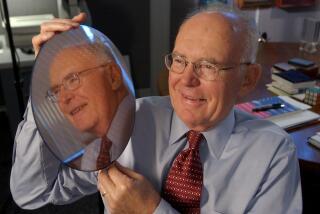Slowing It Down:
- Share via
Moore’s Law states that the power of computer chips doubles every 18 months. But the amount of time a computer will run before its batteries run out seems to improve at a far slower pace.
Now a team of researchers at USC’s Information Sciences Institute in Marina del Rey is building a computer chip that will use one-fifth as much power as a conventional processor--a feat that could extend the battery life of today’s laptop computers by about 50%.
Nearly all of the energy that computers suck out of their power supplies is eventually dissipated as heat. A typical processor uses between 30 and 50 watts of power--enough to run a respectable lightbulb.
Today’s computer chips are designed to use the same amount of power to perform a set number of calculations regardless of how fast the chips churn through them. But that idea didn’t sit well with Bill Athas, a research professor and project leader at the Information Sciences Institute, which is operated by USC’s School of Engineering.
“If you want things to go faster, it should have to cost you power,” Athas said. “If you’re willing to go more slowly, it should cost you less.”
So he and Lars Svensson, a research scientist at ISI, and half a dozen fellow researchers set out to design the AC-1, a microprocessor that slowed the speed at which bits flipped between zero and one to perform calculations. They attached inductors (normally used for radio frequency circuits) to their AC-1 chip to temporarily convert electrical energy into magnetic energy instead of heat. That magnetic energy was later converted back into electrical energy and reused.
Svensson likened the process to a pendulum, which converts potential energy into kinetic energy and back again as it swings.
Tests completed in May showed that the AC-1 used half as much power as an otherwise equivalent chip with conventional circuitry. Further, the AC-1 in its recycling mode used only one-fifth the power it required when it was not hooked up to the inductors.
Based on those results, Athas and Svensson are now working on designs for the next-generation AC-1.1, which they hope will be more than twice as effective as the AC-1.
“If you don’t care how fast you go, you can make a battery last almost forever,” Svensson said. “But the market for an infinitely slow processor is small, so we’re trying to strike a balance. We’re trying to get the best possible energy recovery while maintaining a healthy processing speed.”







